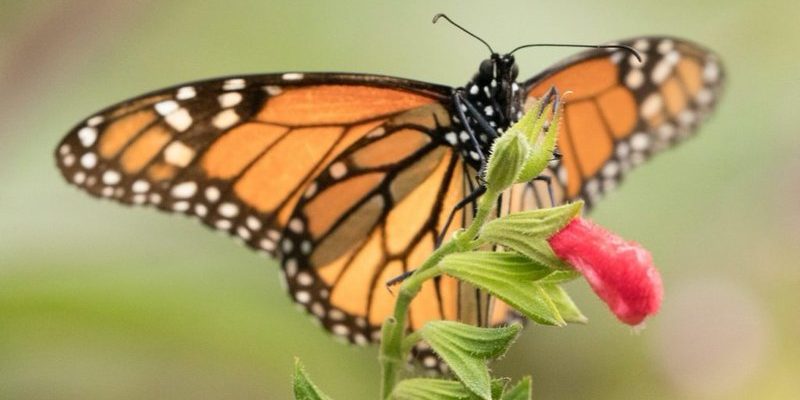
When we think about communication in animals, we often jump to sounds or vocalizations. But keep in mind that there are plenty of creatures, like Monarch butterflies, that speak a different language—one of colors and behaviors. Let’s dive deeper into their world and explore how these stunning insects interact with each other and their environment.
Visual Communication with Color
Monarch butterflies are known for their bright orange wings, but those colors serve more than just a pretty purpose. The vibrant hues act like a warning sign to potential predators. Because these butterflies feed on milkweed, they accumulate toxins that make them taste bad. Their striking colors signal to birds and other predators that they’re not a tasty snack.
But colors aren’t solely for survival. They also play a role in attracting mates. Male Monarchs often display their colors in special flight patterns to impress females. You might see them circling and fluttering in the air, showcasing their vibrant wings. This dance is like a colorful advertisement, saying, “Hey! Look at me! I’m a healthy and vibrant potential mate!” So, next time you see them fluttering, remember: it’s more than just beauty; it’s a whole social dance.
Chemical Communication: Pheromones
Here’s the thing: Monarch butterflies don’t just rely on visuals. They also use scents to communicate. When butterflies are ready to mate, females release specific chemicals called *pheromones*. Think of these as invisible love letters wafting through the air. Male Monarchs can detect these scents from quite a distance, guiding them towards the females.
Once a male detects the pheromones, he starts his courtship dance. He might flutter around the female, showcasing his beauty and elegance. The whole process is like a delicate ballet in a vibrant garden, where scents and colors combine to create a captivating performance. This chemical communication is crucial for reproduction, ensuring that Monarchs find the right partners in their large, migratory journeys.
Touch and Physical Interaction
While colors and smells play a big part in how Monarch butterflies interact, touch is another vital component. When two butterflies meet, they often engage in gentle gestures. This can involve lightly touching their antennae or wings. This physical contact allows them to gain more information about each other, much like how we shake hands or hug to show familiarity and affection.
Such interactions can also help Monarchs establish dominance. During mating rituals, males may engage in brief tussles, touching and pushing against one another to assert their status. It’s not just a matter of survival; it’s about social hierarchies and relationships. This physical communication adds another layer to their complex social lives, illustrating how multifaceted their interactions can be.
Monarchs and Their Environment: Non-verbal Signals
Monarch butterflies communicate not only with one another but also with their environment. For instance, if a Monarch feels threatened—say, by a predator nearby—it may display rapid wing flapping or a sudden change in direction. This is a non-verbal signal to other butterflies, indicating danger is present. It’s like a silent alarm that warns others to be cautious.
In addition, environmental cues can influence their behavior. When Monarchs sense changes in the temperature or light, they may change their flight patterns or feeding habits. This kind of interaction with their surroundings shows how responsive they are to their habitat. They’re not just floating through life; they’re constantly reacting and adjusting to what’s happening around them.
The Importance of Migration in Communication
One of the most remarkable feats of Monarch butterflies is their long-distance migration. Every year, they travel thousands of miles from North America to Mexico. During this incredible journey, communication becomes even more critical. Monarchs rely on visual cues from other butterflies to navigate. They often fly in groups, providing each other with guidance and safety in numbers.
In this migratory process, social interactions also play a role. Monarchs will cluster together in roosts, where they can share cues about the best routes and available food sources. These gatherings ensure that they stay connected and can support one another on their long journey. Without effective communication, this collective movement would be incredibly challenging.
How Understanding Monarch Communication Matters
Studying how Monarch butterflies communicate can reveal much about their behavior and survival. Understanding their methods can also help us focus on conservation efforts. For example, if we know they rely on specific plants like milkweed, we can make better choices about preserving these environments.
Moreover, as we face challenges like climate change, knowing how these butterflies interact with their habitat and each other will be vital. It can guide us in creating conditions that allow them to thrive and continue their migrations. In essence, understanding their communication is not just about knowing butterflies better; it’s about nurturing the ecosystems we share with them.
Monarch butterflies may seem fragile, but their methods of communication are complex and vital for their survival. From dazzling colors to delicate pheromones and physical interactions, they’ve mastered a language all their own.
Whether they’re warning off predators, finding mates, or cooperating on long migrations, every interaction serves a purpose. By learning how these butterflies communicate, we can appreciate their beauty even more. So, the next time you spot a Monarch, take a moment to soak in the wonder behind their vibrant wings and graceful movements. They’re not just fluttering about; they’re engaged in a rich tapestry of life, connecting with each other and their world in ways that are truly remarkable.

